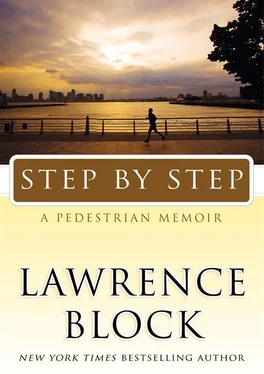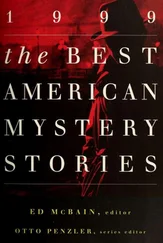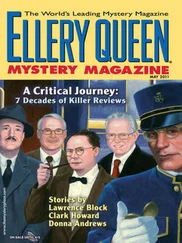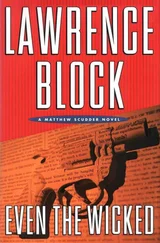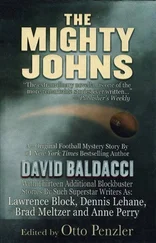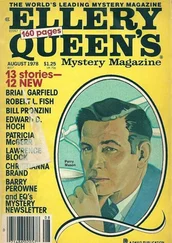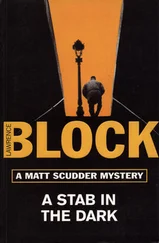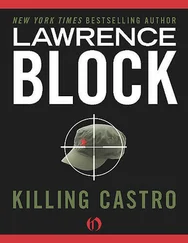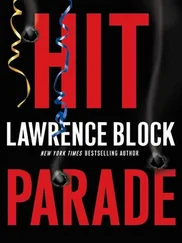Lawrence Block - Step by Step
Здесь есть возможность читать онлайн «Lawrence Block - Step by Step» весь текст электронной книги совершенно бесплатно (целиком полную версию без сокращений). В некоторых случаях можно слушать аудио, скачать через торрент в формате fb2 и присутствует краткое содержание. Год выпуска: 2009, ISBN: 2009, Издательство: William Morrow, Жанр: Биографии и Мемуары, Юмористические книги, на английском языке. Описание произведения, (предисловие) а так же отзывы посетителей доступны на портале библиотеки ЛибКат.
- Название:Step by Step
- Автор:
- Издательство:William Morrow
- Жанр:
- Год:2009
- ISBN:978-0-06-172181-6
- Рейтинг книги:3 / 5. Голосов: 1
-
Избранное:Добавить в избранное
- Отзывы:
-
Ваша оценка:
- 60
- 1
- 2
- 3
- 4
- 5
Step by Step: краткое содержание, описание и аннотация
Предлагаем к чтению аннотацию, описание, краткое содержание или предисловие (зависит от того, что написал сам автор книги «Step by Step»). Если вы не нашли необходимую информацию о книге — напишите в комментариях, мы постараемся отыскать её.
bestselling author comes a touching, insightful, and humorous memoir of an unlikely racewalker and world traveler.
Step by Step — читать онлайн бесплатно полную книгу (весь текст) целиком
Ниже представлен текст книги, разбитый по страницам. Система сохранения места последней прочитанной страницы, позволяет с удобством читать онлайн бесплатно книгу «Step by Step», без необходимости каждый раз заново искать на чём Вы остановились. Поставьте закладку, и сможете в любой момент перейти на страницу, на которой закончили чтение.
Интервал:
Закладка:
But by then I may already have christened any number of trees.
Ah, the special pleasures of the golden years.
For all the stops, I was making good time on the streets of New Orleans. I was very much aware of the racewalkers who were my competitors, and pushed myself to keep pace with this one and edge ahead of that one. It was frustrating the way I would gain ground by pressing and give it back when I made a pit stop. There was one walker I kept overtaking time and time again.
More than half of the walkers were entered in the half-marathon, and left the field after 13.1 miles, upon returning to the Superdome. The rest of us kept going, pushing up Prytania, circling Audubon Park, then backtracking on Prytania to the finish line. On my way up Prytania, I spotted one walker who was already on his way back. There were a couple of others out in front of me, and in the final quarter of the race I began to overtake them. I wasn’t going faster, but their pace had slowed more than mine had, and I was now able to pass them.
In the final mile, I caught sight of a walker a little ways ahead of me. I pressed, and picked up speed, and drew even with him, whereupon he kicked it up a notch. We raced side by side for fifty or a hundred yards, and then I surged and pulled away from him, and somehow knew I wasn’t going to see him again that side of the finish line.
I finished with a net time of 5:17:26, almost four minutes faster than Mobile. Once again I’d taken second place in the male racewalking division, but this time around I was second of eight or nine, not second of two. (To keep things in perspective, the winner was a young man from the Florida panhandle who beat me by about forty minutes.)
It had been a wonderful race, and I came home suffused with a sense of accomplishment and great hopes for the future. My last marathon in 1981 was the Jersey Shore; that, you may recall, was the one I had to finish in five hours in order to be sure of a jacket. I’d racewalked the whole distance in four hours and fifty-three minutes, a mark I never expected to hit again.
But who was to say it was forever out of reach? If I could reduce my time by a minute a mile, I’d get all the way down to 4:51 and change. A minute a mile was a lot, and might well prove impossible, but it seemed to me I had room for improvement. My pace at New Orleans was 12:07 minutes per mile, and back in June I’d managed a pace of 11:18 in a five-miler in Central Park, and my pace in the Queens Half Marathon was only ten seconds a mile faster than that. I’d finished that Queens race with a time of 2:30:22, and the same pace would put me less than a minute over five hours.
Maybe I could break five hours, maybe I could even break 4:53 and set a new personal record for the distance. It seemed impossible, but less so than it had before New Orleans.
Why, the pure deep-down recognition of one’s potential makes possible the realization of that potential. Consider the four-minute mile, an impossible barrier until Roger Bannister broke it. And then, almost immediately, no end of other runners found themselves breaking that impossible barrier. Because they knew it could be done.
5:21 in Mobile, 5:17 in New Orleans. I might never break 4:53, or even five hours, but I could certainly get closer, couldn’t I? I could certainly keep on improving. I could train harder, concentrating on both speed and distance. And I could skip the yerba maté on race mornings, and put something in my stomach. Something salty, say, that might encourage my system to hang on to water instead of sprinkling it on every convenient tree.
I could keep my weight down, and maybe even trim it a little. I’d read somewhere a marathoner’s rule of thumb: one pound equals one mile. Lose ten pounds and you’d shave ten minutes off your time in the marathon. Obviously this only works up to a point, you can’t drop a hundred pounds and challenge the Kenyans, but it’s hard to argue with the premise that the less weight you carry, the more rapidly you can carry it.
There’s a notion that marathoners are thin, and you’d subscribe to it if you should limit your marathon-watching to the first group across the finish line. The winners range from fashion-model lean to anorexically gaunt. Stick around for a look at the back of the pack and you’ll see men and women a lot closer to the national average. There may not be anyone morbidly obese, but a good number of runners will qualify as chunky, and you’ll see Fifty State T-shirts on some of them. Some races even have separate categories for heavier runners, with prizes to the fleetest. (The men are identified as Clydesdales, the women as Athenas, and you have to wonder who thought that one up. A heavy man’s a plow horse, you say, and a heavy woman’s a goddess? Well, okay, I guess. Whatever you say. But who knew the original Athena was a porker in the first place? Sprung full-blown from the brow of Zeus, wasn’t she? Must have been a load off his mind. Rim shot! )
Running can take off pounds, but eating can easily balance the equation, and it’s possible to knock off a couple of marathons a month without ever losing an ounce. Run a few miles, eat a pint of Ben & Jerry’s. Hey, no problem.
But if I knocked off the miles and skipped the Cherry Garcia, I could show up a few pounds lighter and walk a few seconds per mile faster. Age was supposed to be a factor, but I’d continued to grow older since I’d resumed racewalking a little over a year ago, and my times were dropping in spite of it. I was already down to 5:17, so who’s to say just what my limit might be?
Ah well. The mark I set in New Orleans, as it turned out, was one I would never surpass.
19
when i flew home from New Orleans, I was delighted with my performance even as I dreamed of trimming my time. But when I flew to Texas three weeks later, I wasn’t thinking about time. This race was all about distance.
The Houston Ultra Weekend consisted of a whole menu of races, all taking place on a comfortingly flat two-mile asphalt loop in Bear Creek Park. In addition to the twenty-four-hour race, there were six-, twelve-, and forty-eight-hour events, as well as a 100K run. I was signed up for the twenty-four-hour, scheduled to start at eight Saturday morning, and when I got to the course Friday afternoon to pick up my number, the forty-eight-hour race was already under way, and its eight intrepid participants were dutifully putting in the miles. They’d pitched their tents in the infield, so that they could take periodic sleep breaks. I had a hotel room, and went to it.
Saturday morning I met my fellow twenty-four-hour entrants, and there were seven of us — six walkers and a solitary runner. Two certified racewalking judges were on hand to make our race a Centurion event, and Jens Borello had come all the way from Denmark in order to qualify as an American Centurion. (He’d already achieved this distinction in the UK and on the European continent, and has since managed the feat in Australia.)
I knew three of my fellows, although I’d only met one of them before in person. That was Beth Katcher, whom I knew from an online message board, and who’d been on a family trip to New York the last weekend in January. We met by arrangement Sunday morning for a walk along the Hudson, and shortly thereafter she signed up for Houston. I knew Andy Cable and Ollie Nanyes from the boards, too, but was meeting them for the first time.
Just as the forty-eight-hour race hit its halfway mark, ours began.
An hour or two later, so did the rain.
It would have been a perfect race without the rain. It was cool, but not cold enough to require extra clothing. The course was as flat as the North Dakota Marathon, and the park was an ideal setting, private and scenic and entirely free of traffic. The relative abundance of walkers made us feel like full-fledged participants, not like curious slow-moving drones in a hive of runner bees.
Читать дальшеИнтервал:
Закладка:
Похожие книги на «Step by Step»
Представляем Вашему вниманию похожие книги на «Step by Step» списком для выбора. Мы отобрали схожую по названию и смыслу литературу в надежде предоставить читателям больше вариантов отыскать новые, интересные, ещё непрочитанные произведения.
Обсуждение, отзывы о книге «Step by Step» и просто собственные мнения читателей. Оставьте ваши комментарии, напишите, что Вы думаете о произведении, его смысле или главных героях. Укажите что конкретно понравилось, а что нет, и почему Вы так считаете.
